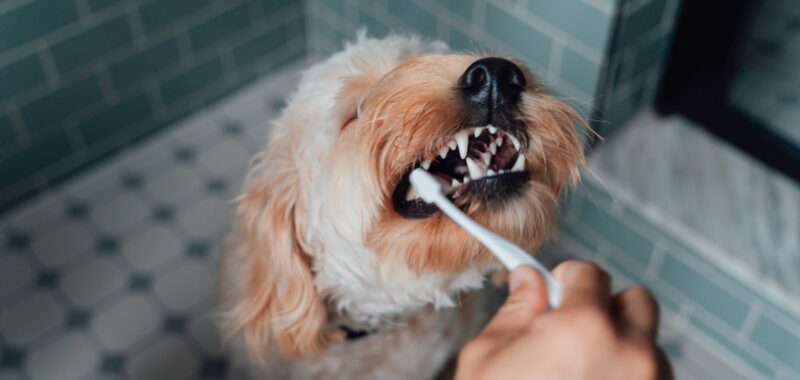We brush our teeth every day to keep our dental hygiene in check, so it makes sense that our dogs should do the same (check out Fido’s breath right now, and you’ll see that it’s a fair assessment). When you have a million other things to do, though, giving your dog a daily dental cleaning might not seem a very high priority in the grand scheme of things. I mean, really, how do you even brush a dog’s teeth?
Spoiler alert: You’ve gotta figure it out because it’s not great to let Fido’s chompers go unchecked. Regular teeth brushing can help improve your dog’s dental health, including warding off bad breath and disease.
“Just like humans, dogs can develop plaque and tartar on their teeth, leading to gum disease and tooth decay,” Dr. Abel Gonzalez, clinical director of Dutch and telemedicine veterinarian, tells Scary Mommy. “Poor dental hygiene can result in bad breath, painful infections, and loss of teeth. Additionally, severe dental diseases can impact a dog’s organs, including the heart and kidneys, as bacteria from the mouth can enter the bloodstream. Smaller breeds and brachycephalic dogs are particularly susceptible to periodontal disease due to genetic factors.”
So, now that you know you should be brushing your dog’s teeth, where do you start? What do you need to use? Below, Gonzalez answers FAQs about brushing dogs’ teeth.
When should I start brushing my dog’s teeth?
According to Gonzales, it’s best to start when they are puppies to get them accustomed early, but it’s never too late to start with older dogs.
How do I clean my dog’s teeth?
Here comes the fun: getting the whole dog-teeth-brushing process down. If you’re starting with a puppy, Gonzalez suggests gradually introducing teeth cleaning by using your finger to rub their gums and teeth gently. Then, “progress to a dog-specific toothbrush and toothpaste, rewarding them with praise and treats to foster positive associations.”
But how, exactly, do you use a toothbrush and toothpaste on a dog? Do you approach it the same general way you brush your teeth? Honestly, it’s not too far from it. Gonzalez offers the following tips and techniques for brushing your dog’s teeth:
- “Ensure your dog is calm, apply a small amount of dog-specific toothpaste to a dog toothbrush, and gently lift your dog’s lips. Use circular motions to brush the teeth, focusing on the gum line and aiming for about 30 seconds on each side.”
- Gonzalez recommends using a soft-bristled toothbrush or a fingerbrush designed for dogs and “always use toothpaste formulated for dogs, avoiding human toothpaste due to its toxicity to dogs.”
- He advises against being too forceful with brushing to prevent gum damage.
- Gonzalez also cautions against ignoring bad breath. Contrary to what you might think, “bad breath should not be dismissed as normal, as it often indicates underlying dental disease.”
- Regular brushing is key to optimal oral health, says Gonzalez. He also recommends using dental chews and water additives as supplementary aids to reduce plaque and tartar buildup. “Regular brushing combined with these aids can significantly improve your dog’s dental health,” he explains.
While it might seem daunting at first, brushing a dog’s teeth falls under the same trite but true saying that so many things do: practice makes perfect. And, really, there’s no such thing as perfect here, so the pressure’s off! The important thing is that you’re putting in some effort and making regular contact between your dog’s teeth and a toothbrush.
When should I see a pro?
Gonzalez recommends scheduling professional cleanings annually or as recommended by your vet. “If you observe bad breath, visible tartar, swollen gums, or changes in eating habits, consult your vet promptly,” he says. “Breeds prone to dental issues may require cleanings twice a year.”
This article was originally published on

